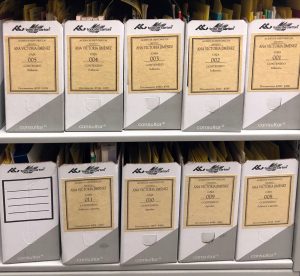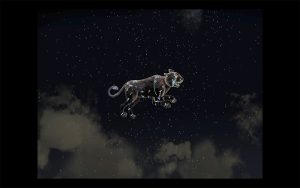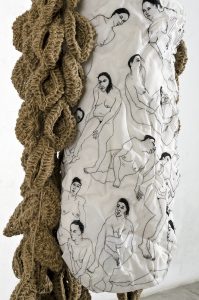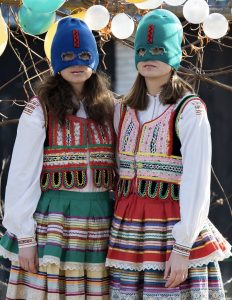By Yohanna M. Roa
Lubeznik Center for the Arts, Michigan City, IN

MARINA VARGAS. Intra-Venus, 2021. Archival inkjet print. Courtesy of the Artist, Sara M. and Michelle Vance Waddell
Presented at the Lubeznik Center for the Arts, a beacon of progressive curatorial practice in Indiana, this exhibition centers women’s aesthetic intelligence, radical visual storytelling, and the expansive generosity of collector and patron Sara M. Vance Waddell, who, alongside her wife Michelle, has gathered one of the most socially conscious private art collections in the Midwest. However, this is not about collecting in the traditional sense. Sara is not interested in art as decoration or a commodity. She collects as a form of cultural rewriting, an act of historic and poetic recovery. She does not just uplift artists; she commits to their ecosystems, their urgencies, and their vocabularies of power. Her collection is not a vault; it is a living archive, and Women to the Front is one of its most daring chapters.
Curated by Whitney Bradshaw, an artist and longtime advocate of intersectional feminist expression, the exhibition features more than 70 works by 59 artists, weaving together a genealogy of visual knowledge that spans generations and geographies. Bradshaw’s curation is not about hierarchy; it is about dialogue, legacy, and interdependence. She curates like a feminist scholar who trusts in the intelligence of images to converse across decades.



ZOË BUCKMAN. Dirty Ruffle, 2017. Boxing glove, vintage wedding dresses, and chain. / PATRICIA CRONIN. Memorial to a Marriage, 2003. Bronze. / JESSICA HARRISON. Painted Lady #9, 2014. Ceramic. Courtesy of the Artists, and Sara M. and Michelle Vance Waddell
The works are not framed by damage, but by imagination. From Louise Bourgeois’s sculptural wisdom to Cindy Sherman’s theatrical personas and Yoko Ono’s conceptual blueprints for peace, the exhibition celebrates how women have transformed form into theory and gesture into history. One of the most compelling inclusions is Marina Vargas, whose work embodies a visceral, baroque sensibility. Her use of religious iconography and the grotesque builds a visual language that fuses myth and flesh, ancestry and agency. Her presence here expands the show’s scope beyond national borders, revealing feminist art as a global conversation.
Zoë Buckman’s embroidered boxing gloves are on view as a visceral gesture that transforms instruments of force into carriers of feminist language and history. In this context, Buckman’s gloves strike a poetic contrast of softness and strength, encapsulating the show’s insistence on art as both tool and testimony. Patricia Cronin’s Memorial to a Marriage, represented in photographic form, anchors the exhibition with its tender reclamation of queer love. The piece invites viewers to witness intimacy as a monument, a gesture of permanence in a world that once erased its possibility. Jessica Harrison appears in the gallery with her sharpened porcelain figurines, once decorative and genteel, now punctured and defiant. Her work subverts notions of femininity with piercing wit, aligning seamlessly with the show’s emphasis on reclaiming and rewriting cultural tropes. Ana de Obregoso’s “Power Vests,’ born from participation in feminist marches, are crafted from diverse garment-like materials and embedded with affirmations—transforming wearable textiles into emotional armor that speaks to the daily realities and resilience of women. Mychaelyn Michalec is represented through intimate drawings and paintings that elevate the mundane: women’s assemblies, nourishing gestures, and household labor become sites of creative agency rather than erasure. In the exhibition, her work reframes ordinary life as an act of collective wisdom. Deborah Kass delivers a series of bold, typographically driven paintings that riff on pop culture and feminist identity. Installed here, her bright canvases feel like visual manifestos, humorous, biting, and assertive, reminding viewers that feminist critique can be playful and intellectually potent.

CHAKAIA BOOKER. Urban Butterfly, 2002. Tires and wood. Courtesy of the Artist, Sara M. and Michelle Vance Waddell
Together, these works epitomize the show’s central ethos: that women artists invent languages, reinvent legacies, and remap the terrains of power—sometimes with thread, sometimes with pigment, always with intention and creative force. Bradshaw’s curatorial hand is firm but never prescriptive. What she builds is a commons, where each work contributes to an evolving landscape of feminist vision. Her project, OUTCRY, which first brought her into connection with Waddell, offered an opening: a scream, yes, but also a call to listen, gather, and amplify.

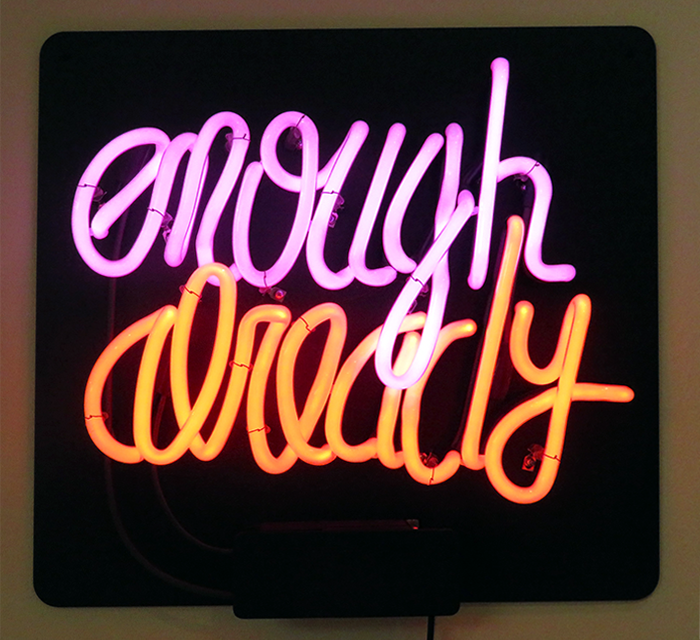

MYCHAELYN MICHALEC I Thought Things Were Getting Better but They Were Not, 2021. Hand and machine tufted yarn rug. DEBORAH KASS. Enough Already, 2012. Neon. / DE ORBEGOSO. Power Vest, 2020. Fabric and thread. Courtesy of the Artists, and Sara M. and Michelle Vance Waddell
What binds this exhibition together is not grievance, but an insistence on creation. Feminist art here is not a reaction it is a proposition, a blueprint for what is possible. These are not wounds on a wall. They are maps, spells, chants, mirrors, and tools.
And the Waddell Collection itself? It is nothing short of revolutionary. It challenges canon by investing in the pluralities of women’s visual vocabularies. It holds space for Midwestern artists like Carolyn L. Mazloomi and Asha White, alongside icons of global feminism. It includes works on boxing, yes, boxing! as a metaphor of endurance, drawn from Sara and Michelle’s own experiences in the ring. Their collection reclaims the gesture of the punch as one of authorship, not just defense.
What is radical here is that feminist art is not treated as a niche or supplemental it is central. It is presented as intellectual, political, and aesthetic leadership. The show recognizes art not just as image, but as knowledge, a different kind of archive, authored by women.

Installation view at the Lubeznik Center for the Arts
And what of Lubeznik itself? To stage this exhibition in a conservative political landscape, at a moment when gender, history, and culture are under threat, is a powerful institutional gesture. The Center becomes not just a gallery, but a site of protection and provocation. It affirms that creativity is a civic act. This exhibition is not about pain; it is about the generative capacity of artists who transmute experience into form. Even when works allude to repression or violence, they do so as a way to imagine otherwise. The show is a luminous reminder that women have never stopped making, building, and dreaming, even when ignored by the market, the academy, or the museum.
To stand before these works is to stand inside a continuum of voice, vision, and future-making. It is also essential to recognize that this history was always here; it was simply not collected, exhibited, or published.
Now it is.
Thanks to the fierce curatorial intelligence of Whitney Bradshaw, the unwavering artistic patronage of Sara and Michelle Vance Waddell, and the institutional courage of the Lubeznik Center for the Arts, we are offered not just a show, but a model: for what feminist cultural memory can look like when we trust women to tell it. “Women to the Front” is not a reckoning. It is a revision a rewriting of art history in full color, full voice, and full power. It leaves no doubt that feminist creativity is not a reaction to crisis, it is the origin of culture itself.
And we are all richer for witnessing it.

MICHELE PRED. Time for Equal Pay II, 2022 Mixed media. Courtesy of the Artist, Sara M. and Michelle Vance Waddell
Exhibiting Artists: Humaira Abid, Marina Abramović, Laura Aguilar, Janine Antoni, Chakaia Booker, Louise Bourgeois, Andrea Bowers, Shelley Brenner Baird, Tania Bruguera, Zoë Buckman, Susan Byrnes, Tania Candiani, Elizabeth Catlett, Sonya Clark, Maryrose Cobarrubias Mendoza, Sue Coe, Patricia Cronin, Carolyn Crump, Ana de Orbegoso, Tracey Emin, Nona Faustine, vanessa german, Guerrilla Girls, Jessica Harrison, Clarity Haynes, Jenny Holzer, Tyra Imani Patterson, Deborah Kass, Baseera Khan, Barbara Kruger, Lilly Manycolors, Delita Martin, Rania Matar, Carolyn L. Mazloomi, Ana Mendieta, Mychaelyn Michalec, Zanele Muholi, Shirin Neshat, Bessie Nickens, Kathy Nida, Yoko Ono, Catherine Opie, Ebony G. Patterson, Judy Polstra, Michele Pred, Sara Rahbar, Francisca Rojas Pohlhammer, Stephanie Rond, Carolee Schneemann, Cindy Sherman, Lorna Simpson, Kiki Smith, Sarah Stolar, Mickalene Thomas, Marina Vargas, Asha White, Hannah Wilke, Carmen Winant, Francesca Woodman
